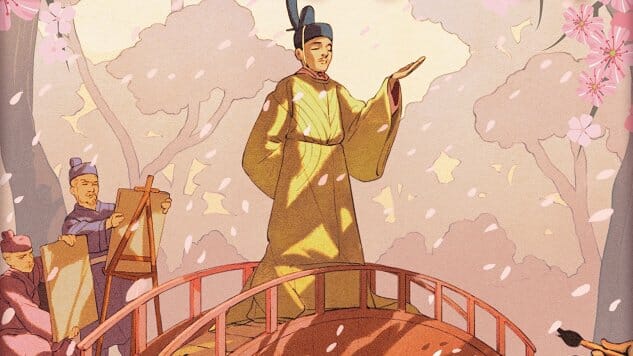Get Ready to Screw Over Your Friends in Reiner Knizia’s Sakura
Photos courtesy of Osprey Games
Sakura is the latest work from prolific game designer Reiner Knizia, who has probably designed a dozen more games in the time it took me to write this review. His biggest hits include Tigris & Euphrates, Lost Cities, Samurai, Ra, Battle Line, and last year’s The Quest for El Dorado, but he has somewhere between 400 and 500 published games to his credit, and the number keeps growing. His games tend to be very mathematical underneath elegant themes, and while some are long (Tigris & Euphrates can run close to two hours if the players are skilled and evenly matched), he’s also pushed out a lot of light, quick-moving games that still manage to appeal to your inner math nerd. Sakura, published by Osprey Games, absolutely fits that description, but pairs it with a very high interactive component: To win, you’re going to have to really screw over your opponents a few times.
In Sakura, players play painters trying to get close to the Emperor to paint his portrait. Everyone walks along a single path which has three points where the Emperor will stop to admire a tree. Each time he stops, the player closest to him gets three or four points, the next-closest player gets two points, and the third-closest gets one point. If, however, any painter bumps into the Emperor—trying to move on to his space—that painter loses a point (token) and moves back three spaces.
Player movement is controlled entirely by cards, with all players playing their cards simultaneously, one per round. The cards are then resolved in numerical order, lowest to highest, with all cards numbered from 1 to 60. Each card has two movement instructions on it, and movement is determined solely by empty spaces—any player pawn that would land on a space occupied by another player’s pawn just jumps it into the next open space. 44 of the 60 cards have a top number that directs you to move the Emperor forward one or two spaces, or lets you choose whether to move the Emperor forward or backward one space. Eight cards instead have a top action that direct you to move the painter closest to the emperor back two spaces; the last eight direct you to move the painter furthest back from the emperor forward two spaces.

-

-

-

-

-

-

-

-

-

-

-

-

-

-

-

-

-

-

-

-

-

-

-

-

-

-

-

-

-

-

-

-

-

-

-

-

-

-

-

-








































